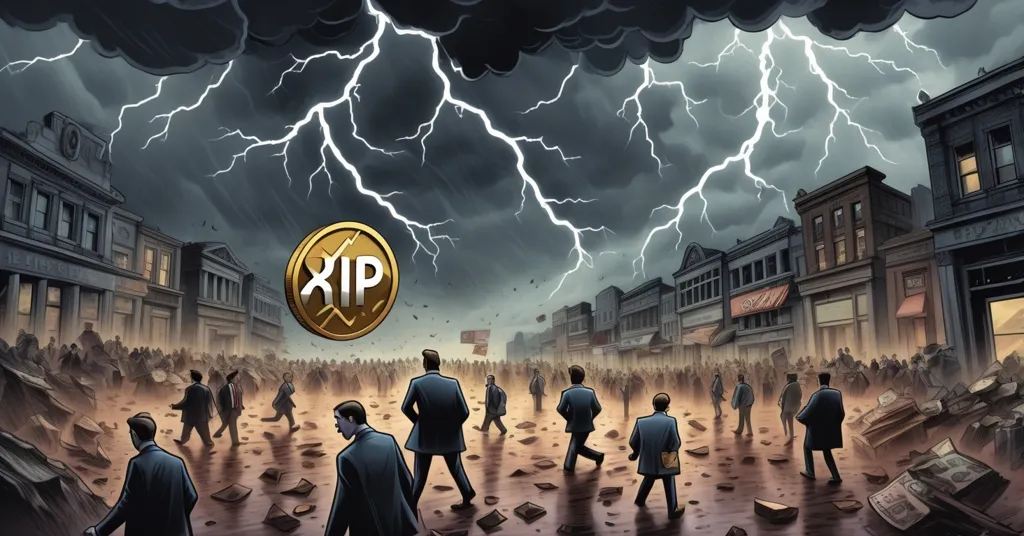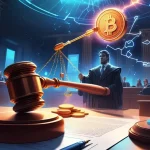XRP Price Crashes as SEC Delays ETF Decisions to 2025, Market Chaos Ensues

XRP Price Plummets as SEC Stalls on ETF Decisions, Uncertainty Reigns
The U.S. Securities and Exchange Commission (SEC) has dropped a bombshell on the XRP community by delaying decisions on five Spot XRP ETF applications, sending the cryptocurrency’s price into a nosedive. Trading at $2.89 after a punishing 3.82% drop in just 24 hours and a hefty 10.84% loss over the past week, XRP is reeling from regulatory indecision, with key rulings now pushed to October 2025.
- SEC postpones rulings on five XRP ETF applications, stoking market fears.
- XRP price sinks to $2.89, reflecting significant daily and weekly declines.
- Decision dates rescheduled for October 18-24, 2025, across Grayscale, 21Shares, Bitwise, CoinShares, and Canary.
- Institutional investors snap up $3.8 billion in XRP as retail traders flee.
Let’s cut to the chase: the SEC’s latest move has shaken XRP to its core, and the fallout is ugly. But beyond the price carnage, there’s a bigger story unfolding about regulatory roadblocks, investor behavior, and XRP’s fight for legitimacy in a skeptical financial world. Stick with us as we unpack the chaos, the context, and what might lie ahead for this embattled altcoin.
Price Plunge: What Went Down?
The numbers paint a grim picture. According to CoinMarketCap data, XRP’s value cratered to $2.89, shedding 3.82% in a single day and a staggering 10.84% over the past week. The worst of it came with a 5.4% single-day drop—the steepest since July—after the token fell below the $3 mark, a price point often seen as a psychological safety net where investors historically pile in to halt further declines. When that barrier broke, panic set in among retail holders, many of whom appear to be dumping their stacks in droves.
But it’s not just cold, hard data telling the tale. Scrolling through social platforms, the sentiment among the self-proclaimed “XRP Army”—a fiercely loyal community of holders—ranges from defiant “HODL” chants to outright despair. Some are calling this a buying opportunity; others are losing faith, venting frustration over yet another regulatory gut punch as seen in online discussions about XRP’s price drop. It’s a stark reminder that in crypto, emotions often move markets as much as fundamentals do.
Regulatory Roadblock: SEC Drags Its Feet Again
The catalyst for this mess? The SEC’s decision to extend its review period for five Spot XRP ETF applications from heavyweights in the crypto investment space. For those unfamiliar, an ETF (exchange-traded fund) is a product traded on stock exchanges that tracks an asset’s price—here, XRP—allowing investors to gain exposure without directly owning the cryptocurrency. Approval of these Spot XRP ETFs would signal mainstream acceptance, potentially drawing in billions from traditional finance. But the SEC isn’t ready to give the green light, citing the need for a deeper evaluation under the Securities Act of 1934, which permits a 60-day delay, as detailed in recent coverage of the SEC’s stance on XRP ETFs.
Here are the new decision dates for 2025: Grayscale XRP Trust on October 18 (via NYSE Arca), 21Shares Core XRP Trust on October 19 (Cboe BZX), Bitwise on October 20 (Cboe BZX), CoinShares XRP ETF on October 23 (Nasdaq), and Canary XRP Trust Share on October 24 (Cboe BZX). That’s a long wait—over a year—for a market that often measures time in Twitter trends and memecoin pumps. And XRP isn’t alone; the SEC has similarly stalled on other altcoin ETFs tied to Litecoin and Solana, as well as hybrid Bitcoin-Ethereum products. It’s a clear pattern: anything beyond Bitcoin and Ethereum, which already have ETF approvals, gets the cold shoulder for now, with more insight into the SEC’s reasoning for these delays.
Why the hesitation? XRP’s baggage with Ripple, the company behind it, looms large. Since 2020, Ripple has been entangled in a high-profile lawsuit with the SEC, which alleges that XRP sales were unregistered securities offerings. This legal shadow has made regulators extra cautious, even as Bitcoin and Ethereum carve out safer reputations in the agency’s eyes. Frankly, it’s no shocker that the SEC is playing it safe—shocker would be if they didn’t—but XRP holders are the ones left bleeding while bureaucrats shuffle papers. For a deeper dive into this ongoing saga, check out the background on Ripple and XRP’s legal challenges.
Market Reactions: Retail Panic vs. Whale Confidence
While retail investors are running for the hills, the big sharks are diving in headfirst. Crypto analyst Ripple Van Winkle highlighted a striking divergence: as small-time traders sell off in a frenzy, institutional players have accumulated a staggering $3.8 billion worth of XRP during this dip. That’s not pocket change; it’s a loud vote of confidence from deep-pocketed entities—possibly hedge funds or crypto-native firms—betting on long-term value where others see only rubble, as explored in analysis of the XRP market impact from SEC delays.
But let’s not get too rosy. Are these whales genuinely bullish on XRP’s fundamentals, or just positioning to flip their stash when retail FOMO inevitably kicks back in? Crypto history is littered with big players pumping and dumping on hype cycles, so skepticism is warranted. Without clearer on-chain data or transparency on who’s buying, it’s hard to call this a pure endorsement. Still, the contrast between retail despair and institutional greed is a fascinating subplot in this unfolding drama.
XRP’s Unique Niche: A Cross-Border Contender
Before we pile on more criticism, let’s give XRP its due. Unlike Bitcoin, which reigns supreme as a decentralized store of value, XRP was built with a specific purpose: fast, cheap cross-border payments. Through RippleNet, a network leveraged by financial institutions, XRP facilitates near-instant transactions across borders, sidestepping the sluggish, costly systems of traditional banking. Transactions settle in seconds, compared to days for wire transfers, and at a fraction of the cost—a compelling pitch for banks and remittance services.
Bitcoin doesn’t compete here, nor does it aim to. BTC’s strength lies in its unassailable decentralization and role as digital gold, not in micromanaging payment rails. XRP, for all its flaws, fills a gap in the financial revolution that Bitcoin neither can nor should address. With partnerships spanning hundreds of institutions globally, Ripple’s vision isn’t just hot air—there’s real utility. Yet, the centralized control Ripple exerts over much of XRP’s supply remains a sticking point for purists like myself who champion Bitcoin’s ethos of freedom from any single point of failure.
Technical Outlook: Breakout or Breakdown?
Can XRP claw its way back, or is more pain on the horizon? Technical analysts are eyeing a chart pattern known as a symmetrical triangle, where price swings tighten over time, like a coiled spring ready to snap. In plain terms, it means a big move is coming—up or down. If XRP pushes past resistance between $3.08 and $3.14, and especially if it clears $3.26, a rally toward $3.9 could be in play. But if momentum stalls and it slips below $2.96, we’re looking at deeper lows and uglier headlines.
Here’s the catch: technical analysis in crypto is often more guesswork than gospel. Markets this volatile, especially ones swayed by regulatory bombshells, don’t always respect pretty chart lines. So while these price levels offer a roadmap, don’t bet your life savings on them. The real driver here isn’t a candlestick pattern—it’s whether the SEC’s shadow over XRP ever lifts, a topic of much debate in discussions on the impact of SEC delays.
Long-Term Play: Beyond 2025
Looking past the immediate wreckage, there’s a flicker of hope for XRP. A major development came after these ETF delays were announced: Ripple and the SEC agreed to dismiss appeals, effectively wrapping up the long-running lawsuit as of late 2023. This resolution could ease regulatory tensions, potentially smoothing the path for ETF approvals by October 2025. It’s not a guarantee, but it’s a step toward clarity that XRP sorely needs, as highlighted in updates on the Ripple lawsuit resolution and its market effects.
Other catalysts loom as well. A shift in SEC leadership—say, after the 2024 U.S. election—or new crypto-friendly legislation like the FIT21 Act could reshape the landscape. Bloomberg ETF analysts note that these delays are procedural, not a death sentence, and industry experts peg the odds of an eventual XRP ETF approval at a surprising 95%, ranking it alongside Litecoin and Solana as top altcoin contenders. Yet, not everyone’s on board—BlackRock, the world’s largest asset manager, has flat-out said it won’t touch an XRP ETF. That’s a red flag from traditional finance, and it tempers the optimism. Are these high approval odds just analyst daydreams, or rooted in precedent? Time will tell, but you can explore more on XRP ETF approval likelihood and institutional trends.
Bitcoin Maximalist Take: XRP’s Role in the Revolution
As someone who leans toward Bitcoin maximalism, I’ll be blunt: XRP will never match BTC’s purity. Bitcoin’s decentralized backbone, free from corporate overlords, is the true rebellion against a broken financial system. XRP, tied so closely to Ripple’s control, feels more like a compromise than a revolution. That said, I can’t deny its niche. Cross-border payments are a real problem, and XRP tackles it in ways Bitcoin doesn’t. Altcoins like this have a place in pushing the broader mission of financial freedom, even if they’re not the endgame. Diversity in the ecosystem drives innovation—just don’t expect me to trade my sats for XRP anytime soon.
One more note of caution: amidst this turmoil, ignore the TikTok shills screaming “XRP to $100” or peddling fake recovery predictions. That’s pure noise, not insight. XRP’s future hinges on tangible progress—regulatory wins, adoption, utility—not empty moonshot hype. We’re here to drive real understanding, not feed delusions.
Key Takeaways and Questions on XRP’s Path Forward
- What sparked the recent XRP price crash?
The SEC’s delay of rulings on five Spot XRP ETF applications triggered widespread uncertainty, driving the price down to $2.89. - When will the SEC rule on these XRP ETF applications?
Decisions are now set for October 18 to 24, 2025, with specific dates for Grayscale (18th), 21Shares (19th), Bitwise (20th), CoinShares (23rd), and Canary (24th). - How are investors reacting to the SEC’s indecision?
Retail traders are selling off in panic, while institutional players have scooped up $3.8 billion in XRP, signaling confidence in future gains. - Is recovery possible for XRP, or is more downside coming?
Technical patterns suggest a rally to $3.9 if XRP breaks $3.26, but a drop below $2.96 looms if resistance holds—though regulatory news will likely outweigh charts. - Does the Ripple-SEC lawsuit resolution change anything?
The recent end to appeals could reduce regulatory friction, potentially boosting sentiment ahead of the 2025 ETF decisions, though immediate impact remains unclear. - Why do XRP ETF delays matter for the broader crypto space?
These delays reflect the SEC’s caution toward altcoins, raising questions about whether regulators are safeguarding investors or stifling blockchain innovation.
The SEC’s foot-dragging is a brutal hit to XRP’s near-term outlook, and the price reflects that raw, unfiltered pain. Yet, with institutional heavyweights stacking chips, a high likelihood of eventual ETF approval, and the Ripple lawsuit finally in the rearview, this could be a classic case of enduring the storm before a breakout. XRP’s journey mirrors the broader crypto struggle for legitimacy—full of speed bumps, if not outright cliffs. If these ETFs get the nod in 2025, will they turbocharge adoption, or just inflate another altcoin bubble? The clock’s ticking on crypto’s fight for freedom from regulatory chains. Keep your eyes on October 2025, and don’t let any single headline trick you into betting the farm.


